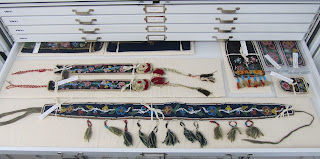When it
comes to the museum’s collections, Rusty tends to steal the show. He’s always the first animal we think of,
followed by the other animals and birds scattered across the museum galleries: when
people ask me what’s really at the
museum, I always tell them about the walruses in Mammal Hall, or Dunky, the
Devonian age fish in Iowa Hall (after Rusty, of course).
But if
you take a trip around Iowa Hall, you’ll find a whole host of other artifacts in the archaeology
section – clay pots, beaded jewelry, and who could forget the bear claw
necklace?
And
although we’ve written of the birds and animals in museum storage, there are
also plenty of ethnographic items in the museum vault, right next to Hornaday’s
birds. Open up the white drawers and
you’ll find items from all kinds of far-flung places: beaded vests, ceremonial
objects, children’s playthings. They
come from multiple continents – places hard to get to, or hardly there at all –
and decades long gone. Most of all, they
come from cultures I’ve never seen and people I’ve never met: looking in the
drawers is looking at another place and time.
And wherever, whenever, the item comes from, it’s always somewhere very different
from downtown Iowa City or its surrounding corn (and soybean) fields.
 We put a
lot of stock in the written word: at museums, I always search for the paragraph
or two of explanation accompanying an exhibit, sometimes before I’ve even
glanced at the objects. And the shelves
of memoirs and autobiographies at the local bookstore speak to our faith in the
written records people leave behind. But these artifacts in the museum vault
have no convenient blurbs, no letters or diary entries attached to them – maybe
a tag indicating where and when they come from, but not much more. They speak for themselves, and invite us to
fill in the blanks. Who sewed all those
beads? Who carved that arrow? Who really used that toy? And why?
We put a
lot of stock in the written word: at museums, I always search for the paragraph
or two of explanation accompanying an exhibit, sometimes before I’ve even
glanced at the objects. And the shelves
of memoirs and autobiographies at the local bookstore speak to our faith in the
written records people leave behind. But these artifacts in the museum vault
have no convenient blurbs, no letters or diary entries attached to them – maybe
a tag indicating where and when they come from, but not much more. They speak for themselves, and invite us to
fill in the blanks. Who sewed all those
beads? Who carved that arrow? Who really used that toy? And why?  Even if
we research and learn more about the artifacts – the ethnographic items in the
main gallery, for example, all have a sentence or two of explanation – the
questions still stand. After all, every
item in the collections has its own fascinating, and perhaps unfathomable,
history. Each item’s been passed from
person to person, hand to hand, over the course of months or years, until it makes
its way to our collections, so that you or I can wonder where it came from, and
try our hands at filling in the blanks.
Even if
we research and learn more about the artifacts – the ethnographic items in the
main gallery, for example, all have a sentence or two of explanation – the
questions still stand. After all, every
item in the collections has its own fascinating, and perhaps unfathomable,
history. Each item’s been passed from
person to person, hand to hand, over the course of months or years, until it makes
its way to our collections, so that you or I can wonder where it came from, and
try our hands at filling in the blanks.
(And
that applies to the rest of the collections, too: where’d those walruses really come from?)
-Written by MNH Volunteer Catherine Babikian


No comments:
Post a Comment